An Optimal and Distributed Demand Response Strategy for Energy Internet Management
Abstract
:1. Introduction
2. Problem Formulation
3. The Demand Response Algorithm
4. Simulation and Results
4.1. Test Description
4.2. Simulation Results
5. Discussion
6. Conclusions and Future Studies
Acknowledgments
Author Contributions
Conflicts of Interest
Nomenclature
| control and prediction horizon | the amount of microgrids | ||
| The index of mircogrid | the minimum/maximum charging power | ||
| ESD unit energy level | the minimum/maximum discharging power | ||
| the forecasted critical load demand and curtaillable load demand | the power curtailment ratio | ||
| the set of schedulable appliances | the load demand of appliance | ||
| the earliest start and latest end time of appliance | the capacity of the PV plant and the wind farm | ||
| the operation cost | the penalty cost coefficient for curtailing flexible loads | ||
| the operation and maintenance cost of the ESD | a vector which denotes the discharging power of the ESD units | ||
| the charge efficiency, discharge efficiency and the self-discharge loss of the ESD | the purchasing/selling power of microgrid in time interval | ||
| the generation of the utility company in time interval | the generation of PV plants | ||
| the maximum power generation | the generation of wind farms | ||
| the generation of CDG units | |||
| the discharging/charging power of the ESD units | maximum ramp up/down power of the utility | ||
| the aggregated load demand | EMS | energy management system | |
| the minimum/maximum power generation of the CDG units | PDOM | parallel distributed optimization method | |
| the ramp up/down power of the CDG units | SDOM | sequential distributed optimization method | |
| the operation cost | MG | microgrid | |
| the purchasing/selling power price for the microgrid users | FC | fuel cell | |
| the minimum/maximum purchasing power limit | ESD | energy storage devices | |
| the minimum/maximum selling power limit | CDG | controllable distributed generation | |
| the purchasing/selling statuses of the microgrid in time interval | RES | renewable energy sources | |
| PSO | Particle Swarm Optimization | ILOG’s CPLEX | A toolbox for linear optimization |
| PV | photovoltaic | YALMIP | A Matlab based toolbox for optimization |
References
- Wang, W.; Xu, Y.; Khanna, M. A survey on the communication architectures in smart grid. Comput. Netw. 2011, 55, 3604–3629. [Google Scholar] [CrossRef]
- Barroso, L.A.; Rudnick, H.; Sensfuss, F.; Linares, P. The Green Effect. IEEE Power Energy Mag. 2010, 8, 22–35. [Google Scholar] [CrossRef]
- Yassine, A. Cooperative Games among Consumers in the Smart Grid. In Proceedings of the 2013 IEEE GCC Conference and Exhibition, Doha, Qatar, 17–20 November 2013; pp. 70–75. [Google Scholar]
- Zhang, D.; Shah, N.; Papageorgiou, L.G. Efficient energy consumption and operation management in a smart building with microgrid. Energy Convers. Manag. 2013, 74, 209–222. [Google Scholar] [CrossRef]
- Parisio, A.; Glielmo, L. A Mixed Integer Linear Formulation for Microgrid Economic Scheduling. In Proceedings of the Virtual Power Plants, Distributed Generation, Microgrids, Renewables and Storage (IEEE SmartGridComm), Brussels, Belgium, 17–20 October 2011; pp. 505–510. [Google Scholar]
- Zhang, Y.; Zhang, T.; Liu, Y.; Guo, B. Stochastic Model Predictive Control for Energy Management Optimization of an Energy Local Network. Proc. CSEE 2016, 36, 3451–3462. [Google Scholar]
- Palensky, P.; Dietrich, D. Demand Side Management: Demand Response, Intelligent Energy Systems, and Smart Loads. IEEE Trans. Ind. Inform. 2011, 7, 381–388. [Google Scholar] [CrossRef]
- Yang, P.; Chavali, P.; Nehorai, A. Parallel Autonomous Optimization of Demand Response with Renewable Distributed Generators. In Proceedings of the IEEE SmartGridComm 2012 Symposium-Demand Side Management, Demand Response, Dynamic Pricing, Tainan, Taiwan, 5–8 November 2012; pp. 55–60. [Google Scholar]
- Wu, Q.; Wang, L.; Cheng, H. Research of TOU power price based on multi-objective optimization of DSM and costs of power consumers. In Proceedings of the International Conference on Electric Utility Deregulation, Restructuring and Power Technologies, Hong Kong, China, 5–8 April 2004; pp. 343–348. [Google Scholar]
- Celebi, E.; Fuller, J.D. A model for efficient consumer pricing schemes in electricity markets. IEEE Trans. Power Syst. 2007, 22, 60–67. [Google Scholar] [CrossRef]
- Chen, C.; Wang, J. MPC-Based Appliance Scheduling for Residential Building Energy Management Controller. IEEE Trans. Smart Grid 2013, 4, 1401–1410. [Google Scholar] [CrossRef]
- Dominguez-Garcia, A.D.; Hadjicostis, C.N. Distributed Algorithms for Control of Demand Response and Distributed Energy Resources. In Proceedings of the 2011 50th IEEE Conference on Decision and Control and European Control Conference (CDC-ECC), Orlando, FL, USA, 12–15 December 2011; pp. 27–32. [Google Scholar]
- Yang, P.; Chavali, P.; Gilboa, E.; Nehorai, A. Parallel Load Schedule Optimization with Renewable Distributed Generators in Smart Grids. IEEE Trans. Smart Grid 2013, 4, 1431–1441. [Google Scholar] [CrossRef]
- Tan, Z.; Yang, P.; Nehorai, A. An Optimal and Distributed Demand Response Strategy with Electric Vehicles in the Smart Grid. IEEE Trans. Smart Grid 2014, 5, 861–869. [Google Scholar] [CrossRef]
- Mírez, J.; Hernández-Callejo, L.; Horn, M.; Bonilla, L.M. Simulation of DC Microgrid and Study of Power and Battery Charge/Discharge Management. Energetic Technol. Energ. Energy Distrib. 2017, 92, 673–679. [Google Scholar]
- Mírez, J. A modeling and simulation of optimized interconnection between DC microgrids with novel strategies of voltage, power and control. In Proceedings of the 2017 IEEE Second International Conference on DC Microgrids (ICDCM), Núremberg, Germany, 27–29 June 2017; pp. 536–541. [Google Scholar]
- Ou, T.C.; Hong, C.M. Dynamic operation and control of microgrid hybrid power systems. Energy 2014, 66, 314–323. [Google Scholar] [CrossRef]
- Ou, T.C.; Su, W.-F.; Liu, X.-Z.; Huang, S.-J.; Tai, T.-Y. A Modified Bird-Mating Optimization with Hill-Climbing for Connection Decisions of Transformers. Energies 2016, 9, 671. [Google Scholar] [CrossRef]
- Ou, T.C.; Lu, K.H.; Huang, C.J. Improvement of Transient Stability in a Hybrid Power Multi-System Using a Designed NIDC (Novel Intelligent Damping Controller). Energies 2017, 10, 488. [Google Scholar] [CrossRef]
- Amini, M.H.; Nabi, B.; Haghifam, M.R. Load management using multi-agent systems in smart distribution network. In Proceedings of the 2013 IEEE Power and Energy Society General Meeting, Vancouver, BC, Canada, 21–25 July 2013; pp. 1–5. [Google Scholar]
- Bui, V.H.; Hussain, A.; Kim, H.M. Optimal Operation of Microgrids Considering Auto-Configuration Function Using Multiagent System. Energies 2017, 10, 1484. [Google Scholar] [CrossRef]
- Gomez-Sanz, J.J.; Garcia-Rodriguez, S.; Cuartero-Soler, N.; Hernandez-Callejo, L. Reviewing Microgrids from a Multi-Agent Systems Perspective. Energies 2014, 7, 3355–3382. [Google Scholar] [CrossRef]
- Haider, H.T.; See, O.H.; Elmenreich, W. Residential demand response scheme based on adaptive consumption level pricing. Energy 2016, 113, 301–308. [Google Scholar] [CrossRef]
- Safamehr, H.; Rahimi-Kian, A. A cost-efficient and reliable energy management of a micro-grid using intelligent demand-response program. Energy 2015, 91, 283–293. [Google Scholar] [CrossRef]
- Ou, T.C. A novel unsymmetrical faults analysis for microgrid distribution systems. Int. J. Electr. Power Energy Syst. 2012, 43, 1017–1024. [Google Scholar] [CrossRef]
- Ou, T.C. Ground fault current analysis with a direct building algorithm for microgrid distribution. Int. J. Electr. Power Energy Syst. 2013, 53, 867–875. [Google Scholar] [CrossRef]
- Erdinc, O. Economic impacts of small-scale own generating and storage units, and electric vehicles under different demand response strategies for smart households. Appl. Energy 2014, 126, 142–150. [Google Scholar] [CrossRef]
- Grid Data. Available online: http://www.elia.be/en/grid-data/ (accessed on 1 December 2017).
- Zhang, Y.; Zhang, T.; Wang, R.; Liu, Y.; Guo, B. A Model Predictive Control Based Distributed Coordination of Multi-microgrids in Energy Internet. Acta Autom. Sin. 2017, 43, 1443–1456. [Google Scholar]
- Wang, R.; Purshouse, R.C.; Fleming, P.J. Preference-inspired co-evolutionary algorithms for many objective optimization. IEEE Trans. Evol. Comput. 2013, 17, 474–494. [Google Scholar] [CrossRef]
- Wang, R.; Zhang, Q.F.; Zhang, T. Decomposition based algorithms using Pareto adaptive scalarizing methods. IEEE Trans. Evol. Comput. 2016, 20, 821–837. [Google Scholar] [CrossRef]
- Wang, R.; Li, G.; Ming, M.; Wu, G.; Wang, L. An efficient multi-objective model and algorithm for sizing a stand-alone hybrid renewable energy system. Energy 2017, 141, 2288–2299. [Google Scholar] [CrossRef]
- Ming, M.; Wang, R.; Zha, Y.B.; Zhang, T. Multi-objective Optimization of Hybrid Renewable Energy System using an Enhanced Evolutionary Multi-objective Algorithm. Energies 2017, 10, 674. [Google Scholar] [CrossRef]
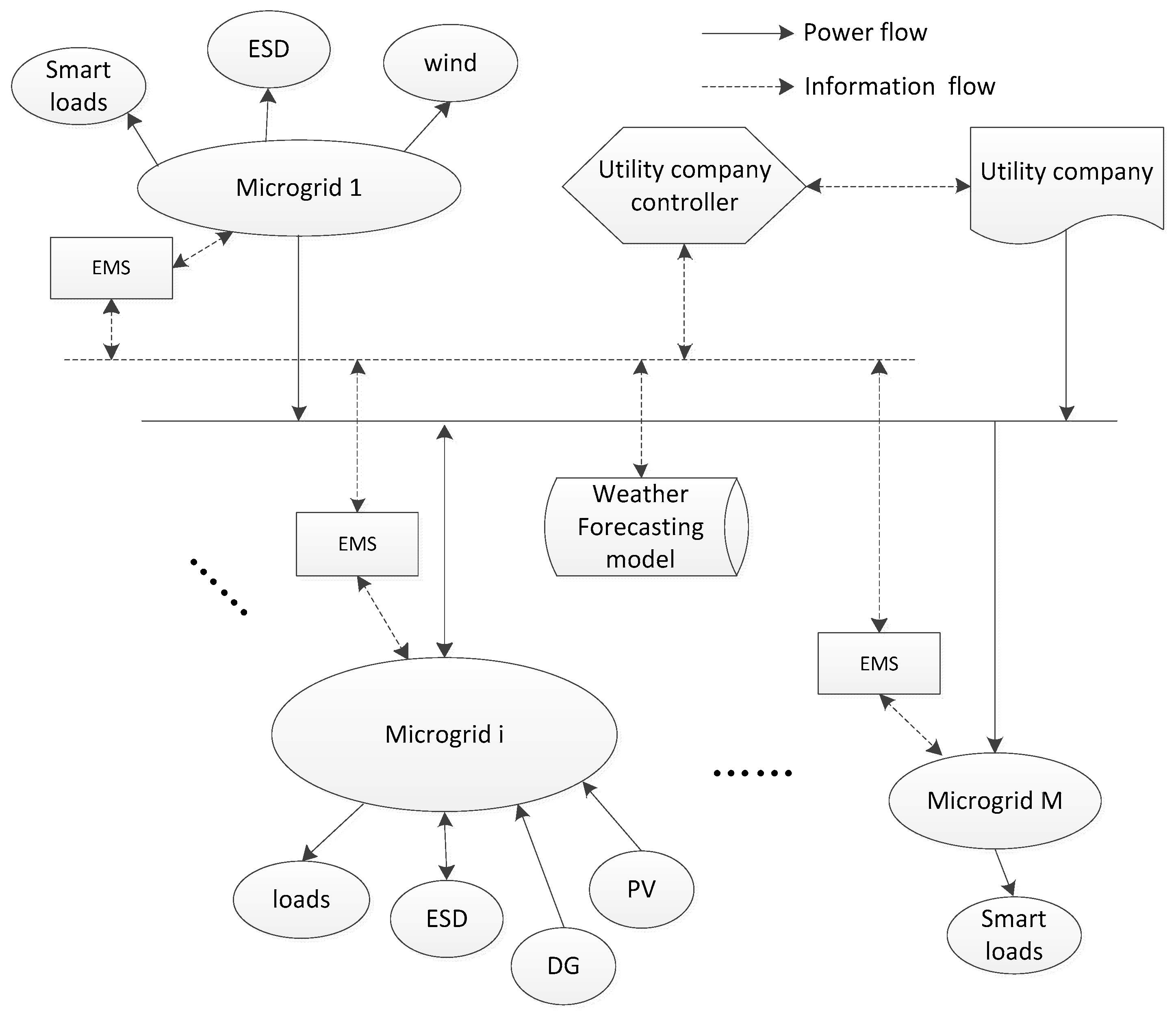

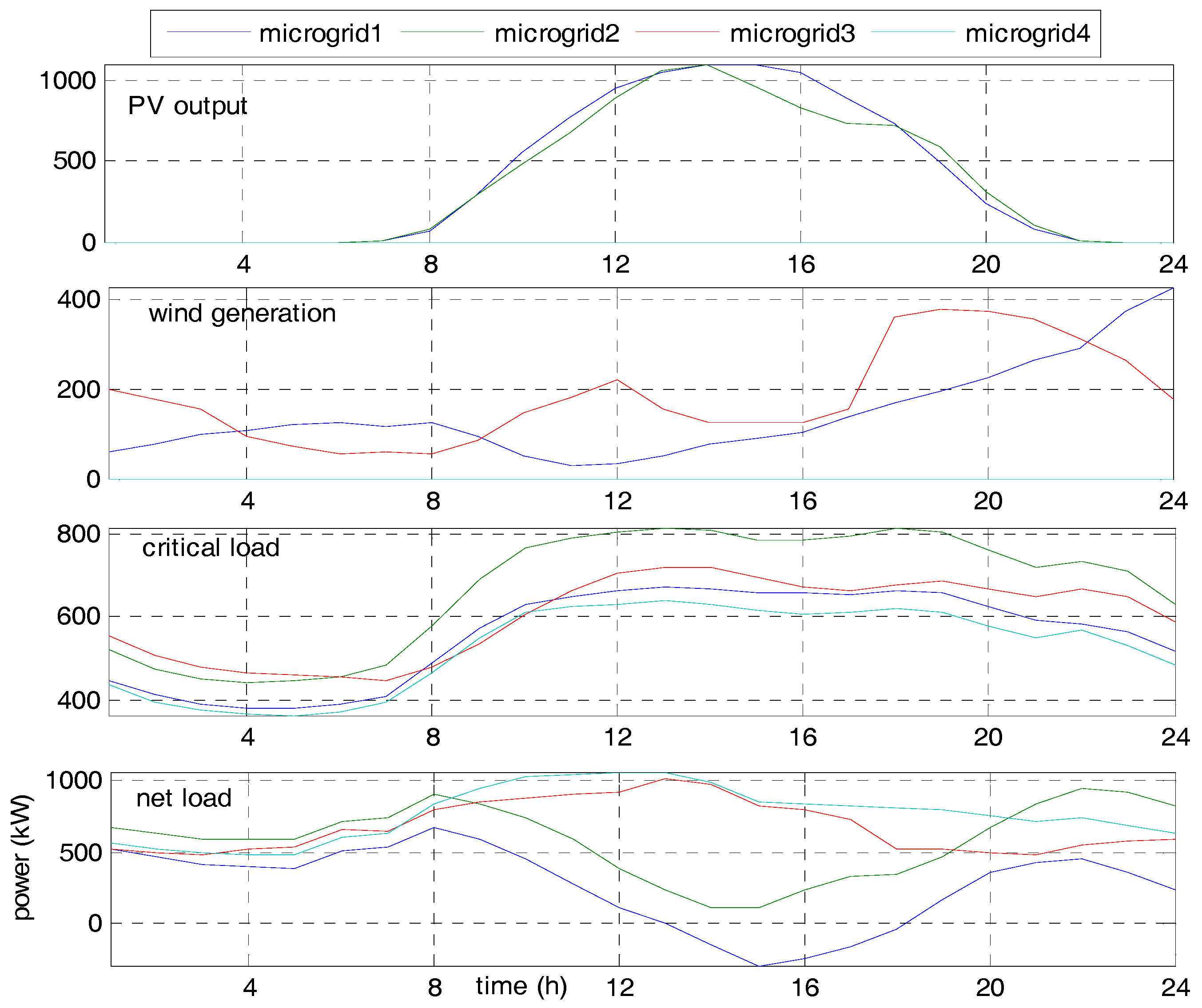
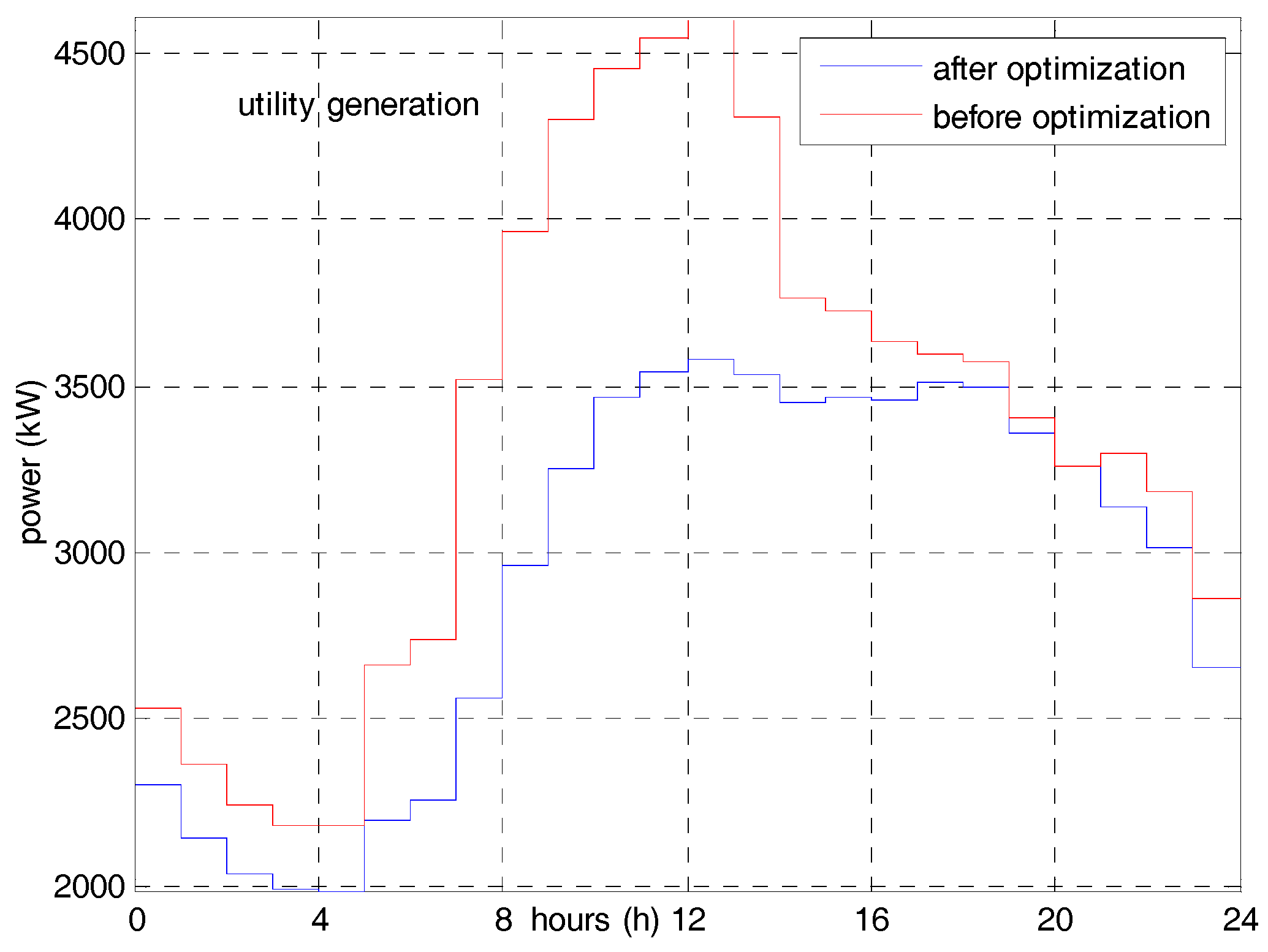
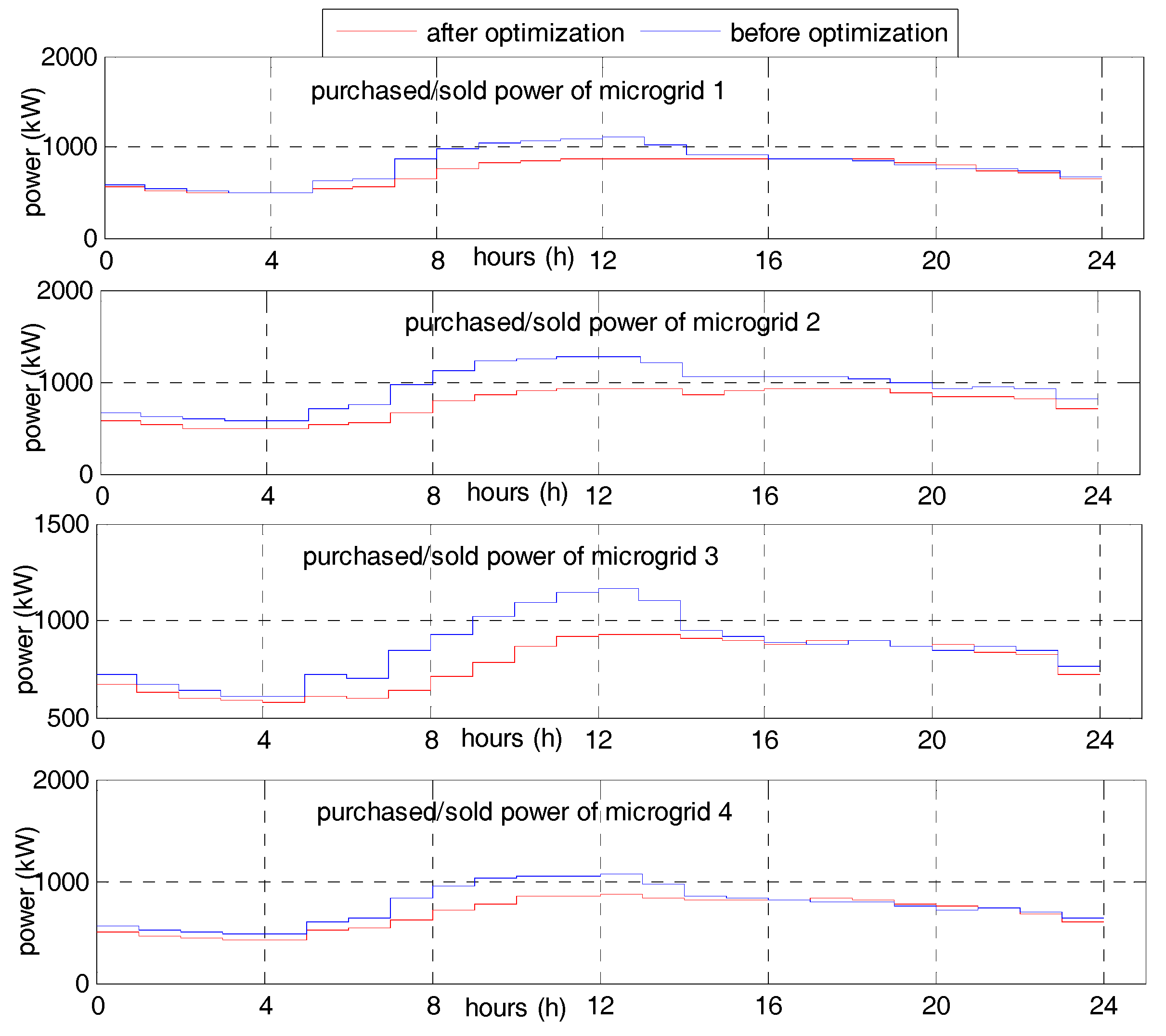
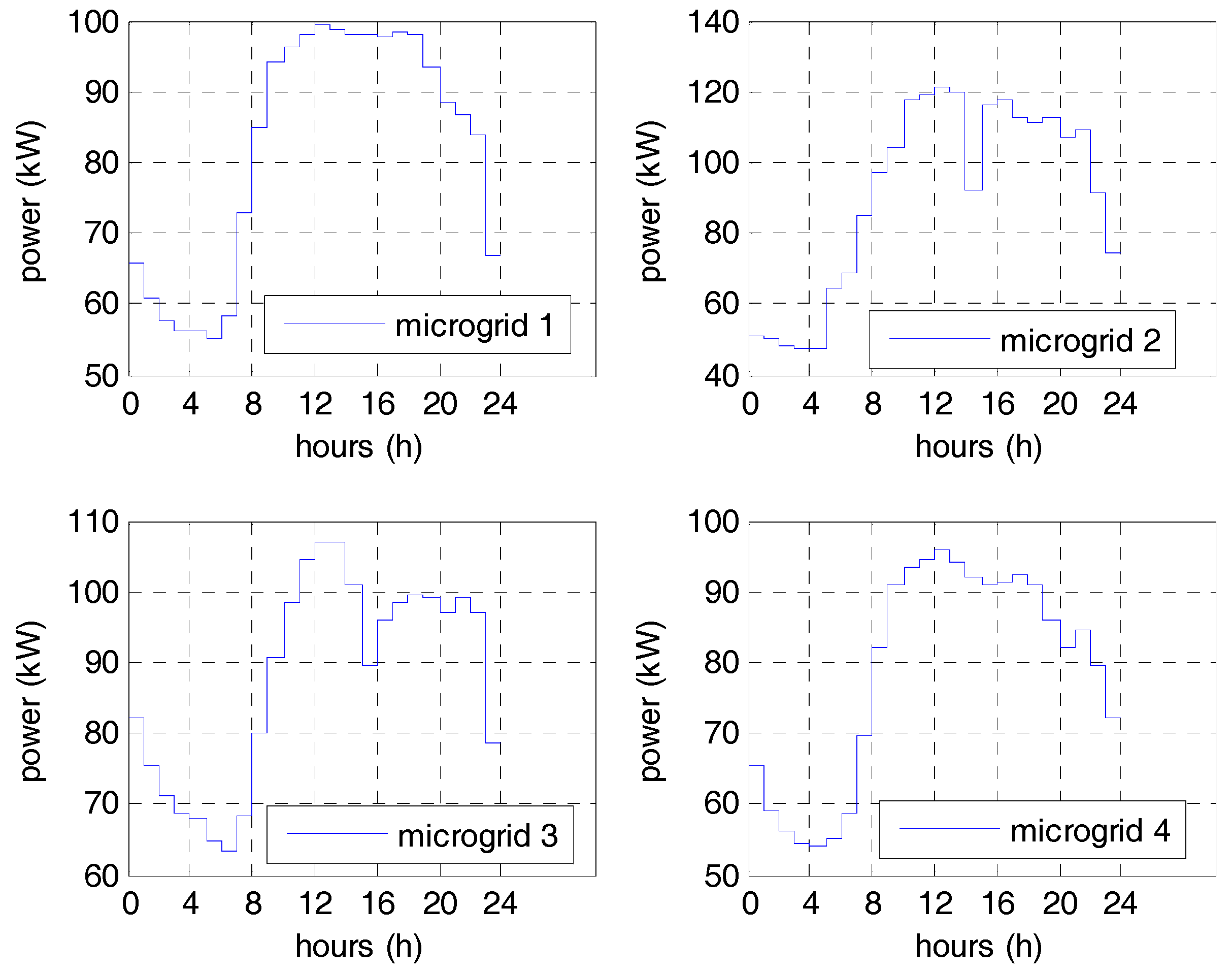

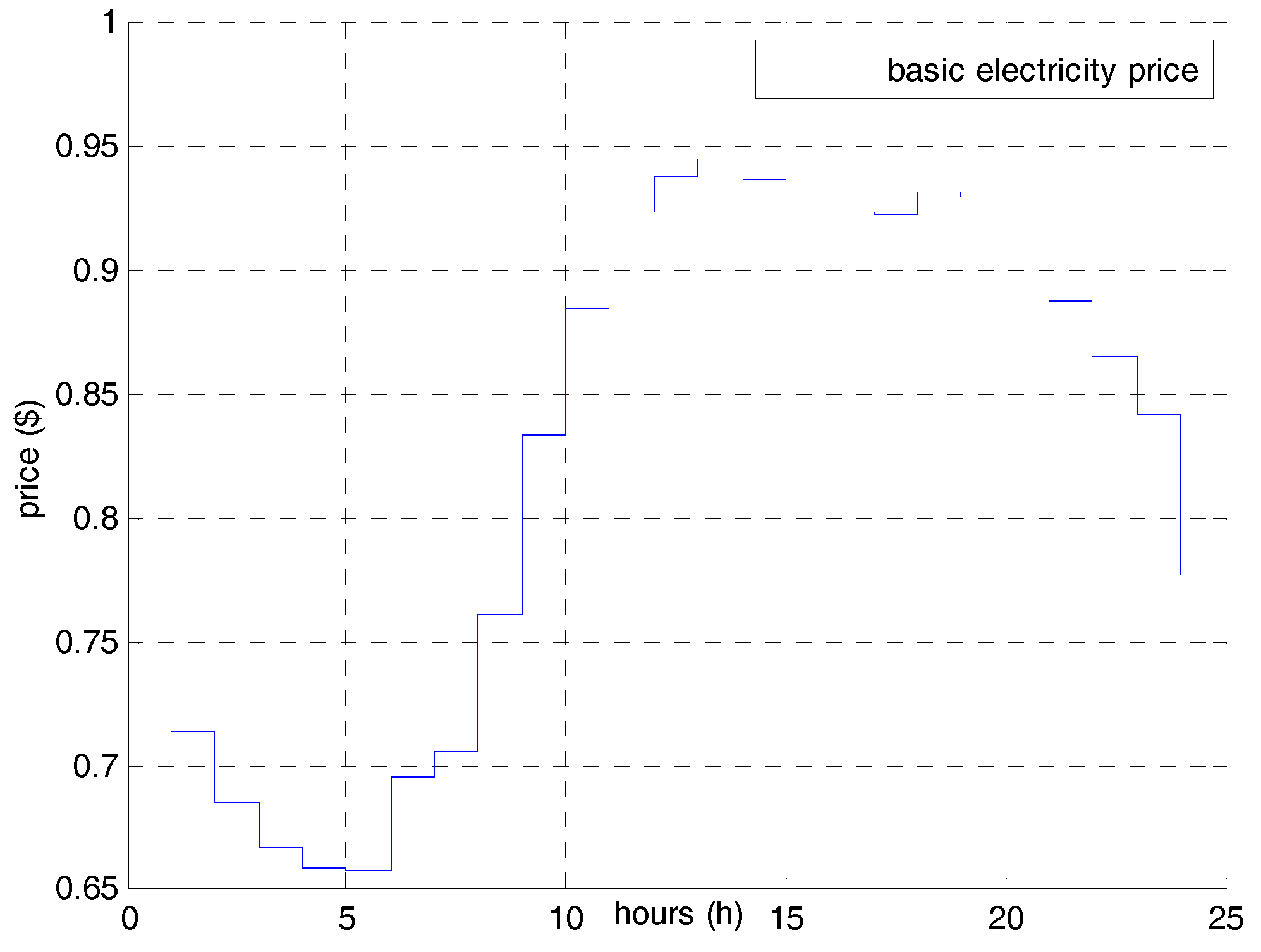
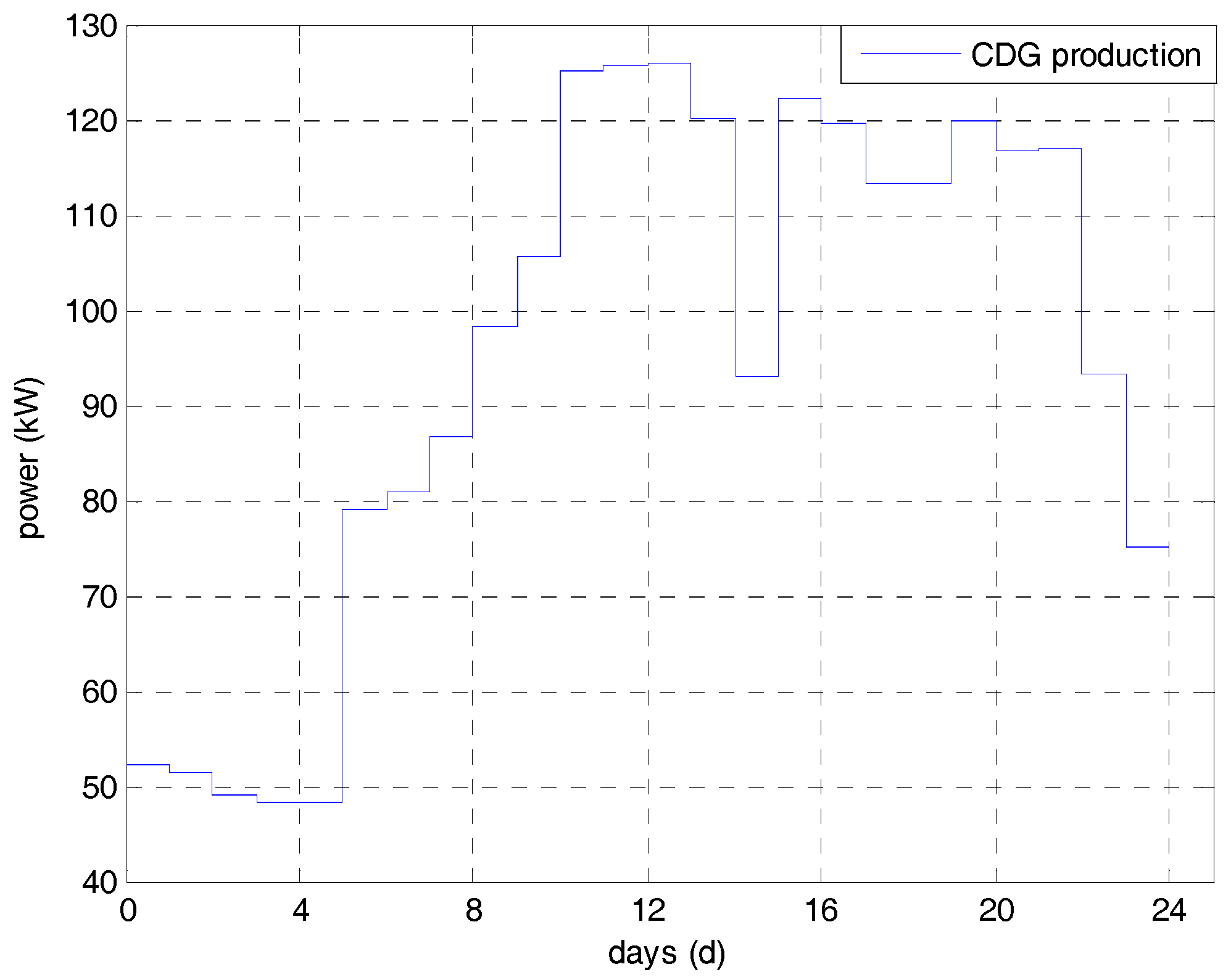
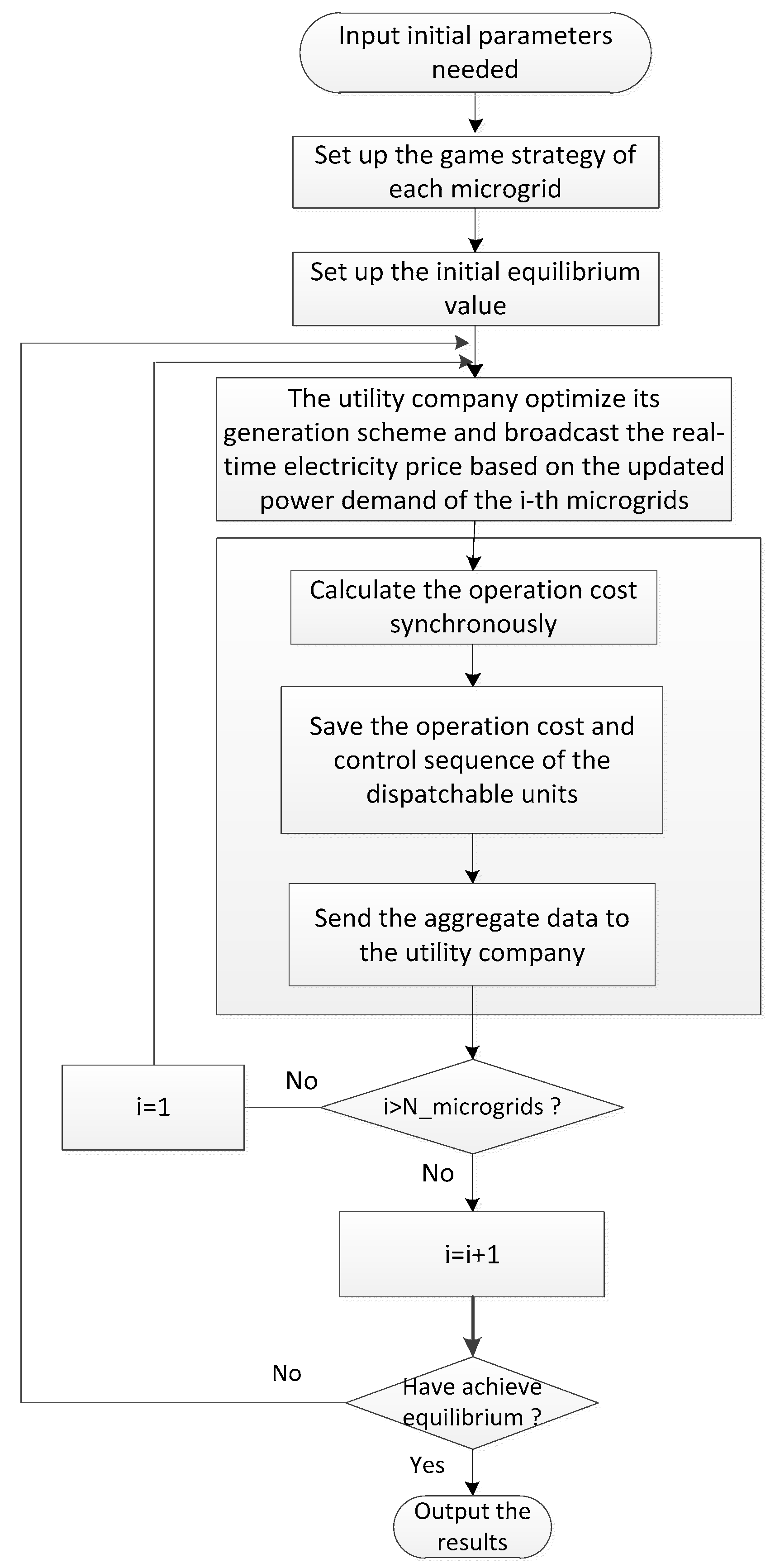
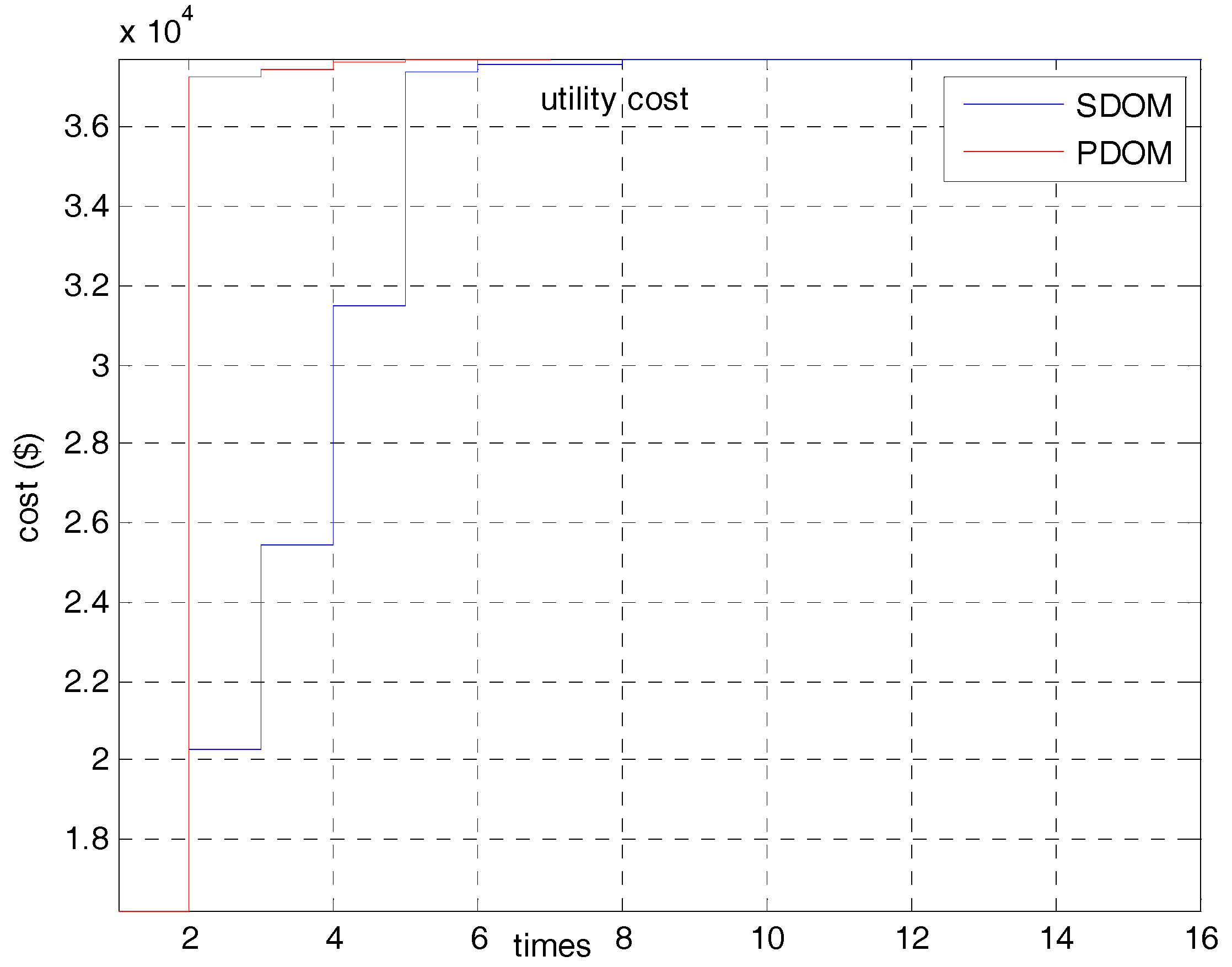

| PV Capacity (kW) | Wind Capacity (kW) | Maximum Exchanging Power (kW) | Maximum Critical Load (kW) | |
|---|---|---|---|---|
| Microgrid 1 | 1100 | 530 | 1000 | 670 |
| Microgrid 2 | 100 | 0 | 1000 | 810 |
| Microgrid 3 | 0 | 660 | 1200 | 720 |
| Microgrid 4 | 0 | 0 | 1500 | 640 |
| Max Power | Min Power | Ramp Rate | Cost Coefficients | |
|---|---|---|---|---|
| Microgrid 2 | 450 | 25 | 400 | 0.0055/0.44 |
| Utility company | 4000 | 100 | 4000 | 0.00018/0.30 |
| Max Charge/Discharge Power | Min Charge/Discharge Power | O&M Cost | Min Energy Level | Max Energy Level | Charge/Discharge Efficiency | |
|---|---|---|---|---|---|---|
| Microgrid 1 | 320 | 10 | 0.054 | 128 | 960 | 0.95 |
| Microgrid 2 | 280 | 16 | 0.058 | 120 | 900 | 0.95 |
| Microgrid 3 | 240 | 12 | 0.057 | 104 | 780 | 0.95 |
| Cost of SDOM | Cost of PDOM | |
|---|---|---|
| Microgrid 1 | 5291 $ | 5266 $ |
| Microgrid 2 | 11,303 $ | 11,349 $ |
| Microgrid 3 | 13,598 $ | 13,574 $ |
| Microgrid 4 | 15,314 $ | 15,342 $ |
© 2018 by the authors. Licensee MDPI, Basel, Switzerland. This article is an open access article distributed under the terms and conditions of the Creative Commons Attribution (CC BY) license (http://creativecommons.org/licenses/by/4.0/).
Share and Cite
Liu, Q.; Wang, R.; Zhang, Y.; Wu, G.; Shi, J. An Optimal and Distributed Demand Response Strategy for Energy Internet Management. Energies 2018, 11, 215. https://doi.org/10.3390/en11010215
Liu Q, Wang R, Zhang Y, Wu G, Shi J. An Optimal and Distributed Demand Response Strategy for Energy Internet Management. Energies. 2018; 11(1):215. https://doi.org/10.3390/en11010215
Chicago/Turabian StyleLiu, Qian, Rui Wang, Yan Zhang, Guohua Wu, and Jianmai Shi. 2018. "An Optimal and Distributed Demand Response Strategy for Energy Internet Management" Energies 11, no. 1: 215. https://doi.org/10.3390/en11010215
APA StyleLiu, Q., Wang, R., Zhang, Y., Wu, G., & Shi, J. (2018). An Optimal and Distributed Demand Response Strategy for Energy Internet Management. Energies, 11(1), 215. https://doi.org/10.3390/en11010215




